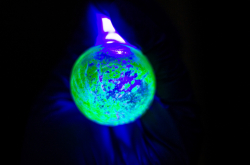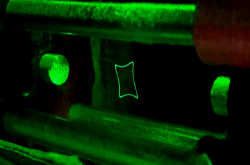This picture was taken by Petr Snetkov, a staff member of ITMO’s School of Photonics, to showcase the rainbow glow of polymeric materials in polarized light. To capture the effect, he used an LCD with a white slide that generates polarized light, a DSLR, and a circular polarizing filter.
The glow effect arises from optical inhomogeneity (or, as scientists say, anisotropy) in initially homogeneous (or isotropic) solid materials, including polymeric ones. Inhomogeneity is caused, in turn, by internal mechanical stresses that are formed in the manufacture of products or due to external influences. In polymers, this effect occurs due to the orientation of polymer chains (macromolecules).
Observation of optical inhomogeneities in polarized light lies at the core of a method that is applied to measure and evaluate the characteristics of the stress state of transparent objects. This can be used, for example, in the technical control of manufactured products or the condition of parts that are exposed to mechanical stress.





